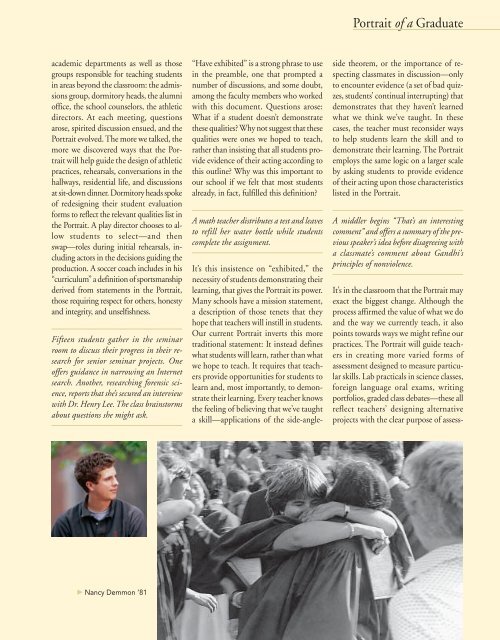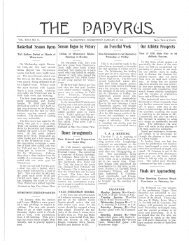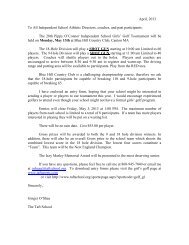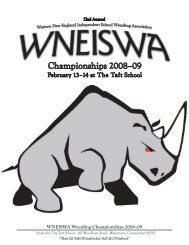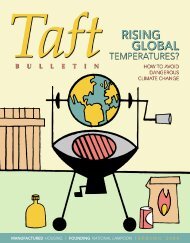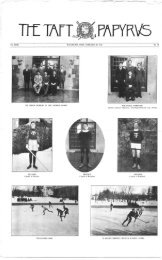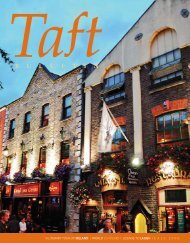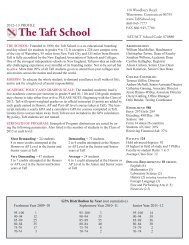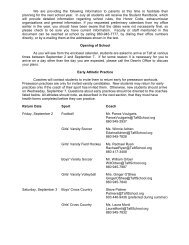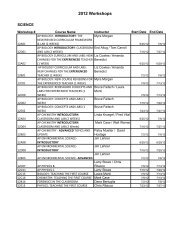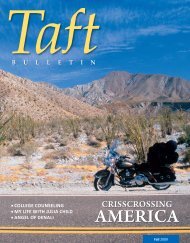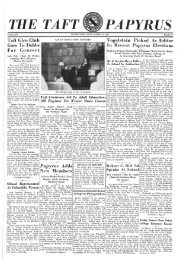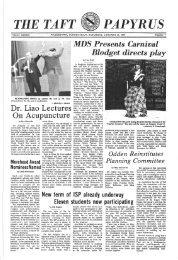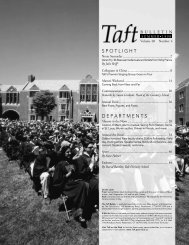B U L L E T I N Taft Portrait of a Graduate - The Taft School
B U L L E T I N Taft Portrait of a Graduate - The Taft School
B U L L E T I N Taft Portrait of a Graduate - The Taft School
- No tags were found...
Create successful ePaper yourself
Turn your PDF publications into a flip-book with our unique Google optimized e-Paper software.
<strong>Portrait</strong> <strong>of</strong> a <strong>Graduate</strong><br />
academic departments as well as those<br />
groups responsible for teaching students<br />
in areas beyond the classroom: the admissions<br />
group, dormitory heads, the alumni<br />
<strong>of</strong>fice, the school counselors, the athletic<br />
directors. At each meeting, questions<br />
arose, spirited discussion ensued, and the<br />
<strong>Portrait</strong> evolved. <strong>The</strong> more we talked, the<br />
more we discovered ways that the <strong>Portrait</strong><br />
will help guide the design <strong>of</strong> athletic<br />
practices, rehearsals, conversations in the<br />
hallways, residential life, and discussions<br />
at sit-down dinner. Dormitory heads spoke<br />
<strong>of</strong> redesigning their student evaluation<br />
forms to reflect the relevant qualities list in<br />
the <strong>Portrait</strong>. A play director chooses to allow<br />
students to select—and then<br />
swap—roles during initial rehearsals, including<br />
actors in the decisions guiding the<br />
production. A soccer coach includes in his<br />
“curriculum” a definition <strong>of</strong> sportsmanship<br />
derived from statements in the <strong>Portrait</strong>,<br />
those requiring respect for others, honesty<br />
and integrity, and unselfishness.<br />
Fifteen students gather in the seminar<br />
room to discuss their progress in their research<br />
for senior seminar projects. One<br />
<strong>of</strong>fers guidance in narrowing an Internet<br />
search. Another, researching forensic science,<br />
reports that she’s secured an interview<br />
with Dr. Henry Lee. <strong>The</strong> class brainstorms<br />
about questions she might ask.<br />
“Have exhibited” is a strong phrase to use<br />
in the preamble, one that prompted a<br />
number <strong>of</strong> discussions, and some doubt,<br />
among the faculty members who worked<br />
with this document. Questions arose:<br />
What if a student doesn’t demonstrate<br />
these qualities Why not suggest that these<br />
qualities were ones we hoped to teach,<br />
rather than insisting that all students provide<br />
evidence <strong>of</strong> their acting according to<br />
this outline Why was this important to<br />
our school if we felt that most students<br />
already, in fact, fulfilled this definition<br />
A math teacher distributes a test and leaves<br />
to refill her water bottle while students<br />
complete the assignment.<br />
It’s this insistence on “exhibited,” the<br />
necessity <strong>of</strong> students demonstrating their<br />
learning, that gives the <strong>Portrait</strong> its power.<br />
Many schools have a mission statement,<br />
a description <strong>of</strong> those tenets that they<br />
hope that teachers will instill in students.<br />
Our current <strong>Portrait</strong> inverts this more<br />
traditional statement: It instead defines<br />
what students will learn, rather than what<br />
we hope to teach. It requires that teachers<br />
provide opportunities for students to<br />
learn and, most importantly, to demonstrate<br />
their learning. Every teacher knows<br />
the feeling <strong>of</strong> believing that we’ve taught<br />
a skill—applications <strong>of</strong> the side-angleside<br />
theorem, or the importance <strong>of</strong> respecting<br />
classmates in discussion—only<br />
to encounter evidence (a set <strong>of</strong> bad quizzes,<br />
students’ continual interrupting) that<br />
demonstrates that they haven’t learned<br />
what we think we’ve taught. In these<br />
cases, the teacher must reconsider ways<br />
to help students learn the skill and to<br />
demonstrate their learning. <strong>The</strong> <strong>Portrait</strong><br />
employs the same logic on a larger scale<br />
by asking students to provide evidence<br />
<strong>of</strong> their acting upon those characteristics<br />
listed in the <strong>Portrait</strong>.<br />
A middler begins “That’s an interesting<br />
comment” and <strong>of</strong>fers a summary <strong>of</strong> the previous<br />
speaker’s idea before disagreeing with<br />
a classmate’s comment about Gandhi’s<br />
principles <strong>of</strong> nonviolence.<br />
It’s in the classroom that the <strong>Portrait</strong> may<br />
exact the biggest change. Although the<br />
process affirmed the value <strong>of</strong> what we do<br />
and the way we currently teach, it also<br />
points towards ways we might refine our<br />
practices. <strong>The</strong> <strong>Portrait</strong> will guide teachers<br />
in creating more varied forms <strong>of</strong><br />
assessment designed to measure particular<br />
skills. Lab practicals in science classes,<br />
foreign language oral exams, writing<br />
portfolios, graded class debates—these all<br />
reflect teachers’ designing alternative<br />
projects with the clear purpose <strong>of</strong> assess-<br />
Nancy Demmon ’81


